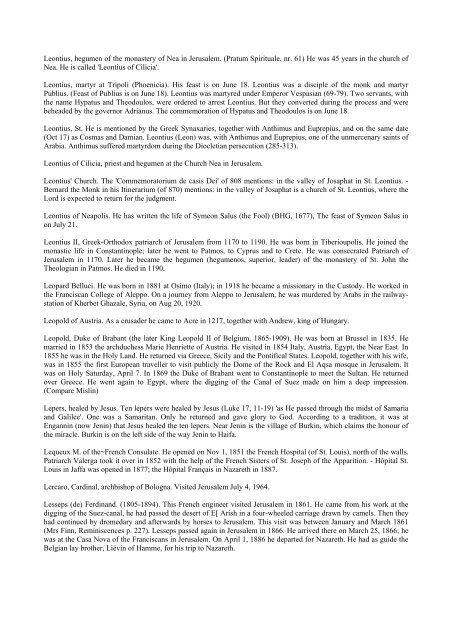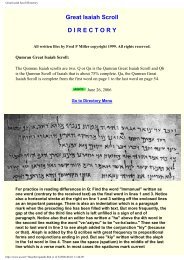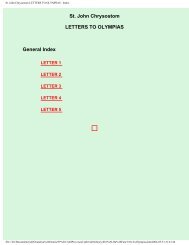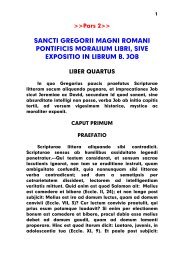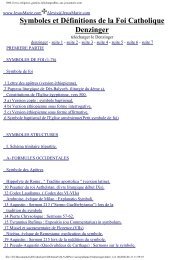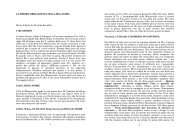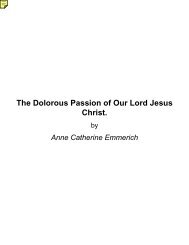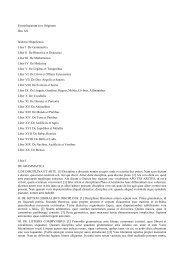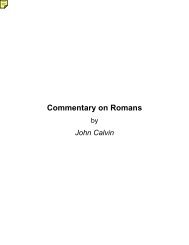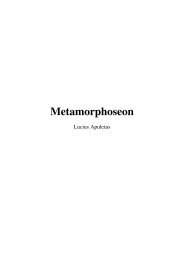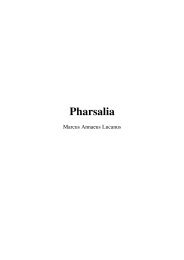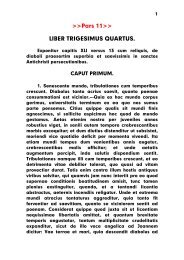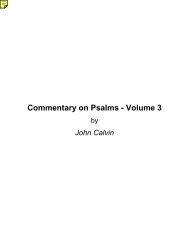List of Christians in the Holy Land - documentacatholicaomnia.eu
List of Christians in the Holy Land - documentacatholicaomnia.eu
List of Christians in the Holy Land - documentacatholicaomnia.eu
- No tags were found...
Create successful ePaper yourself
Turn your PDF publications into a flip-book with our unique Google optimized e-Paper software.
Leontius, hegumen <strong>of</strong> <strong>the</strong> monastery <strong>of</strong> Nea <strong>in</strong> Jerusalem. (Pratum Spirituale, nr. 61) He was 45 years <strong>in</strong> <strong>the</strong> church <strong>of</strong><br />
Nea. He is called 'Leontius <strong>of</strong> Cilicia'.<br />
Leontius, martyr at Tripoli (Phoenicia). His feast is on June 18. Leontius was a disciple <strong>of</strong> <strong>the</strong> monk and martyr<br />
Publius. (Feast <strong>of</strong> Publius is on June 18). Leontius was martyred under Emperor Vespasian (69-79). Two servants, with<br />
<strong>the</strong> name Hypatus and Theodoulos, were ordered to arrest Leontius. But <strong>the</strong>y converted dur<strong>in</strong>g <strong>the</strong> process and were<br />
beheaded by <strong>the</strong> governor Adrianus. The commemoration <strong>of</strong> Hypatus and Theodoulos is on June 18.<br />
Leontius, St. He is mentioned by <strong>the</strong> Greek Synaxaries, toge<strong>the</strong>r with Anthimus and Euprepius, and on <strong>the</strong> same date<br />
(Oct 17) as Cosmas and Damian. Leontius (Leon) was, with Anthimus and Euprepius, one <strong>of</strong> <strong>the</strong> unmercenary sa<strong>in</strong>ts <strong>of</strong><br />
Arabia. Anthimus suffered martyrdom dur<strong>in</strong>g <strong>the</strong> Diocletian persecution (285-313).<br />
Leontius <strong>of</strong> Cilicia, priest and hegumen at <strong>the</strong> Church Nea <strong>in</strong> Jerusalem.<br />
Leontius' Church. The 'Commemoratorium de casis Dei' <strong>of</strong> 808 mentions: <strong>in</strong> <strong>the</strong> valley <strong>of</strong> Josaphat <strong>in</strong> St. Leontius. -<br />
Bernard <strong>the</strong> Monk <strong>in</strong> his It<strong>in</strong>erarium (<strong>of</strong> 870) mentions: <strong>in</strong> <strong>the</strong> valley <strong>of</strong> Josaphat is a church <strong>of</strong> St. Leontius, where <strong>the</strong><br />
Lord is expected to return for <strong>the</strong> judgment.<br />
Leontius <strong>of</strong> Neapolis. He has written <strong>the</strong> life <strong>of</strong> Symeon Salus (<strong>the</strong> Fool) (BHG, 1677), The feast <strong>of</strong> Symeon Salus <strong>in</strong><br />
on July 21.<br />
Leontius II, Greek-Orthodox patriarch <strong>of</strong> Jerusalem from 1170 to 1190. He was born <strong>in</strong> Tiberioupolis. He jo<strong>in</strong>ed <strong>the</strong><br />
monastic life <strong>in</strong> Constant<strong>in</strong>ople; later he went to Patmos, to Cyprus and to Crete. He was consecrated Patriarch <strong>of</strong><br />
Jerusalem <strong>in</strong> 1170. Later he became <strong>the</strong> hegumen (hegumenos, superior, leader) <strong>of</strong> <strong>the</strong> monastery <strong>of</strong> St. John <strong>the</strong><br />
Theologian <strong>in</strong> Patmos. He died <strong>in</strong> 1190.<br />
Leopard Belluci. He was born <strong>in</strong> 1881 at Osimo (Italy); <strong>in</strong> 1918 he became a missionary <strong>in</strong> <strong>the</strong> Custody. He worked <strong>in</strong><br />
<strong>the</strong> Franciscan College <strong>of</strong> Aleppo. On a journey from Aleppo to Jerusalem, he was murdered by Arabs <strong>in</strong> <strong>the</strong> railwaystation<br />
<strong>of</strong> Kherbet Ghazale, Syria, on Aug 20, 1920.<br />
Leopold <strong>of</strong> Austria. As a crusader he came to Acre <strong>in</strong> 1217, toge<strong>the</strong>r with Andrew, k<strong>in</strong>g <strong>of</strong> Hungary.<br />
Leopold, Duke <strong>of</strong> Brabant (<strong>the</strong> later K<strong>in</strong>g Leopold II <strong>of</strong> Belgium, 1865-1909). He was born at Brussel <strong>in</strong> 1835. He<br />
married <strong>in</strong> 1853 <strong>the</strong> archduchess Marie Henriette <strong>of</strong> Austria. He visited <strong>in</strong> 1854 Italy, Austria, Egypt, <strong>the</strong> Near East. In<br />
1855 he was <strong>in</strong> <strong>the</strong> <strong>Holy</strong> <strong>Land</strong>. He returned via Greece, Sicily and <strong>the</strong> Pontifical States. Leopold, toge<strong>the</strong>r with his wife,<br />
was <strong>in</strong> 1855 <strong>the</strong> first European traveller to visit publicly <strong>the</strong> Dome <strong>of</strong> <strong>the</strong> Rock and El Aqsa mosque <strong>in</strong> Jerusalem. It<br />
was on <strong>Holy</strong> Saturday, April 7. In 1869 <strong>the</strong> Duke <strong>of</strong> Brabant went to Constant<strong>in</strong>ople to meet <strong>the</strong> Sultan. He returned<br />
over Greece. He went aga<strong>in</strong> to Egypt, where <strong>the</strong> digg<strong>in</strong>g <strong>of</strong> <strong>the</strong> Canal <strong>of</strong> Suez made on him a deep impression.<br />
(Compare Misl<strong>in</strong>)<br />
Lepers, healed by Jesus. Ten lepers were healed by Jesus (Luke 17, 11-19) 'as He passed through <strong>the</strong> midst <strong>of</strong> Samaria<br />
and Galilee'. One was a Samaritan. Only he returned and gave glory to God. Accord<strong>in</strong>g to a tradition, it was at<br />
Engann<strong>in</strong> (now Jen<strong>in</strong>) that Jesus healed <strong>the</strong> ten lepers. Near Jen<strong>in</strong> is <strong>the</strong> village <strong>of</strong> Burk<strong>in</strong>, which claims <strong>the</strong> honour <strong>of</strong><br />
<strong>the</strong> miracle. Burk<strong>in</strong> is on <strong>the</strong> left side <strong>of</strong> <strong>the</strong> way Jen<strong>in</strong> to Haifa.<br />
Lequ<strong>eu</strong>x M. <strong>of</strong> <strong>the</strong>~French Consulate. He opened on Nov 1, 1851 <strong>the</strong> French Hospital (<strong>of</strong> St. Louis), north <strong>of</strong> <strong>the</strong> walls.<br />
Patriarch Valerga took it over <strong>in</strong> 1852 with <strong>the</strong> help <strong>of</strong> <strong>the</strong> French Sisters <strong>of</strong> St. Joseph <strong>of</strong> <strong>the</strong> Apparition. - Hôpital St.<br />
Louis <strong>in</strong> Jaffa was opened <strong>in</strong> 1877; <strong>the</strong> Hôpital Français <strong>in</strong> Nazareth <strong>in</strong> 1887.<br />
Lercaro, Card<strong>in</strong>al, archbishop <strong>of</strong> Bologna. Visited Jerusalem July 4, 1964.<br />
Lesseps (de) Ferd<strong>in</strong>and. (1805-1894). This French eng<strong>in</strong>eer visited Jerusalem <strong>in</strong> 1861. He came from his work at <strong>the</strong><br />
digg<strong>in</strong>g <strong>of</strong> <strong>the</strong> Suez-canal, he had passed <strong>the</strong> desert <strong>of</strong> E[ Arish <strong>in</strong> a four-wheeled carriage drawn by camels. Then <strong>the</strong>y<br />
had cont<strong>in</strong>ued by dromedary and afterwards by horses to Jerusalem. This visit was between January and March 1861<br />
(Mrs F<strong>in</strong>n, Rem<strong>in</strong>iscences p. 227). Lesseps passed aga<strong>in</strong> <strong>in</strong> Jerusalem <strong>in</strong> 1866. He arrived <strong>the</strong>re on March 25, 1866; he<br />
was at <strong>the</strong> Casa Nova <strong>of</strong> <strong>the</strong> Franciscans <strong>in</strong> Jerusalem. On April 1, 1886 he departed for Nazareth. He had as guide <strong>the</strong><br />
Belgian lay bro<strong>the</strong>r, Liév<strong>in</strong> <strong>of</strong> Hamme, for his trip to Nazareth.


